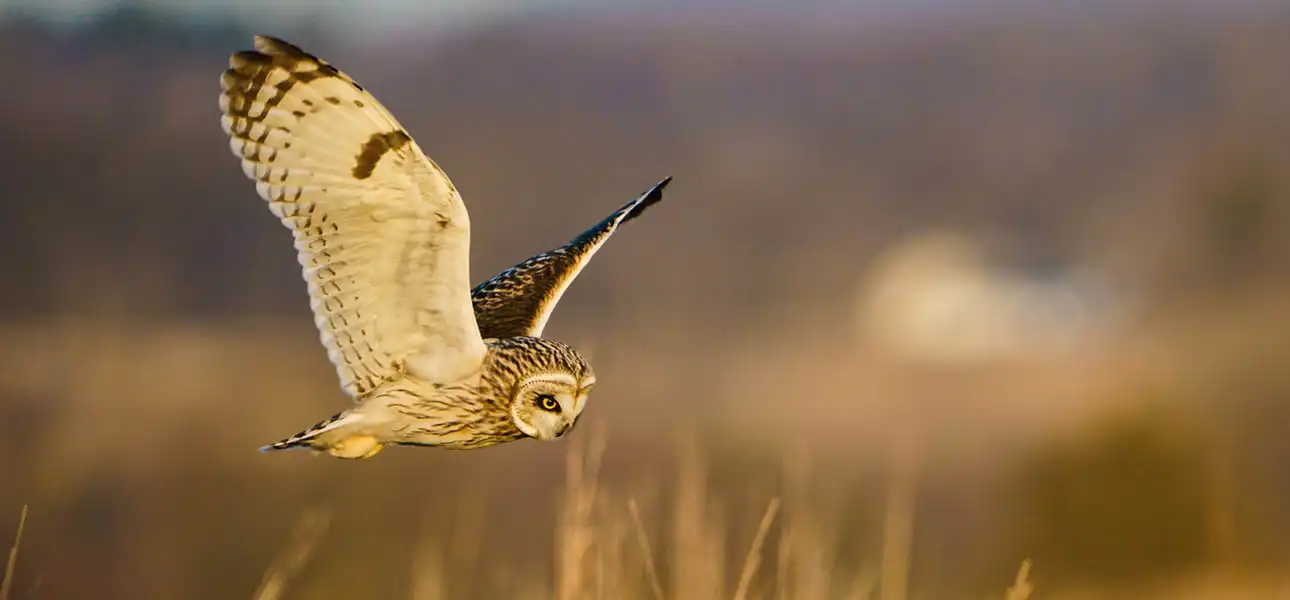
Little compares to the astonishing and piercing stare of a Short-eared Owl! Bright yellow eyes, set in black which seem kohl-rimmed and a bird not afraid to stare at you, whilst sitting in the open during the day. Short-eared Owls in winter, when they are more likely to be encountered outside of their restricted breeding range, are often active during the day. Initial impressions can be of a sandy-coloured Buzzard, but the blunt head is immediately obvious. Long, paddle-shaped wings carry the bird low over the grassy habitats it hunts over.
Key Facts
Common name: Short-eared Owl
Scientific name: Asio flammeus
Habitat: Wild, open habitats
Diet: Small mammals
Size: 38cm; wingspan: 102cm. Weight 330g
Status: Migrant/resident breeding bird. Passage. Winter visitor
Population size: 620 pairs (more with migration in winter months)
Conservation status: AMBER due to recent population and range declines
Appearance
The bird is named after two small feather tufts on the top of its head, which look like ears (although the bird’s real ears are hidden away on the side of the head, covered in the head feathers), but most of the time these are not visible as they are held flat to the head.
Confusion is most likely with Long-eared Owl, although normally these will be in wooded areas, but large numbers do winter here, and birds can occasionally be seen flying in daylight in coastal areas. Likewise, where heath meets woodland, there is the chance of either species at dusk as Long-eared Owls may come out of the wood to hunt in nearby habitats. In flight, the two are surprisingly similar, and care must be taken separating them.
Lifespan
Relatively short-lived. Records are very few, but the oldest known wild ringed bird was 6½ years old. Annual survival rates are not known.
Nesting
Short-eared Owls are highly terrestrial and, although they may readily perch on posts while hunting, they usually roost and nest on the ground in a simple nest scrape. Males display with spectacular flapping display flights over the potential nest site to attract females, but once on eggs the birds are highly secretive.
Breeding success is highly dependent on good populations of prey. Even in good years, owls are unlikely to have more than one brood, but clutch sizes may be larger. As ground nesters, the young leave the nest quite early.
Number of eggs: 4-7
Incubation: 27 days
Fledging time: 26-32 days
Habitat and Distribution
After Barn Owl, Short-eared Owl is one of the most widespread species, occurring on all continents except Antarctica and Australia, although avoiding tropical regions. In the UK, they are birds of wild, open habitats and are found principally in North Wales, the Pennines and upland northern England, moorlands of Scotland, Hebrides and Orkney during the breeding season. These birds move to lower altitudes during the winter and are joined by varying numbers of birds from northern Europe and Scandinavia on lowland rough grassland and heath, with birds found potentially anywhere there is suitable habitat. They avoid wooded areas, and even roost on the ground.
Movements
Highly migratory, British Short-eared Owls generally remain in the country, although move down slope of their breeding habitats into rough grassland and coastal areas. More northerly birds from northern Europe and Scandinavia are subject to prey population variations and in years of low prey numbers, large migrations of Short-eared Owls into UK can be experienced, with recently arrived birds conspicuously quartering coastal grassland during the day.
Feeding
Small mammals are the main prey of Short-eared Owls, mostly voles. Hunting birds' quarter likely habitat, flying low back and forth, with concentrated focus on the ground below. Prey is located by sound in long grass and, despite the frequent sightings of this owl during the day, most hunting takes place at night. In favoured sites in winter groups can gather, and the birds will roost communally.

